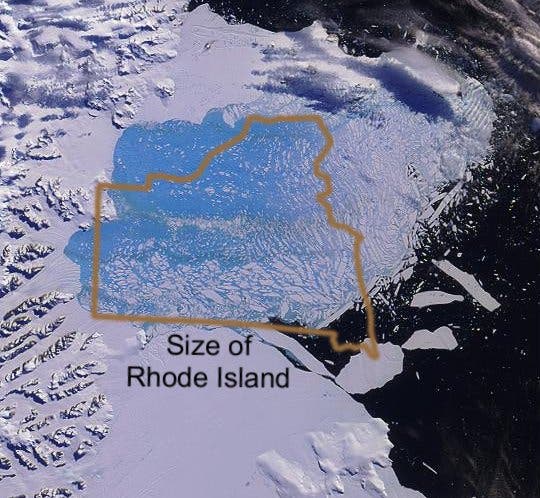A NASA study has found that a huge ice shelf is set to collapse in a few years. The ice shelf, which has existed for over 12,000 years and is estimated to be over 200 meters thick will reach its end by 2020.

“These are warning signs that the remnant is disintegrating,” said Ala Khazendar of Nasa’s Jet Propulsion Laboratory (JPL) in Pasadena, California.
But as interesting as this is scientifically, it’s extremely worrying to see such a giant melt and collapse.
“Although it’s fascinating scientifically to have a front-row seat to watch the ice shelf becoming unstable and breaking up, it’s bad news for our planet. This ice shelf has existed for at least 10,000 years, and soon it will be gone.”
Named after Captain Carl Anton Larsen, a famous Norwegian sailor, the Larsen ice shelf has three sections – Larsen A, Larsen B, and Larsen C. Larsen B, comparable in size to Rhode Island, partially collapsed in 2002, when 3,250 km² of ice 220 m thick disintegrated, raising concerns about ice thinning. Now, the NASA report indicates that it will collapse completely by 2020.
“This study of the Antarctic Peninsula glaciers provides insights about how ice shelves farther south, which hold much more land ice, will react to a warming climate,” said Eric Rignot, co-author of the study and a glaciologist at NASA’s Jet Propulsion Laboratory in Pasadena, California.

Indeed, the main culprit seems to be man-caused global warming. Ocean warming is literally off the charts, and of course, warmer waters accentuate glacier melting. Despite what the media might claim, there is almost a scientific consensus about global warming – it’s happening, and we’re causing it.
The only good news is that the collapse of the glacier won’t contribute to rising sea levels.
“What matters is how much more ice the glaciers will dump into the ocean once this ice shelf is removed,” Khazendar said. “Some of these glaciers are most likely already contributing to sea level rise because they are in the process of accelerating and thinning.”
According to the British Antarctic Survey, the Antarctic is the fastest warming area in the world, warming by 5 degrees Fahrenheit (2.8 degrees Celsius) in the past 50 years. This March, the peninsula set an unofficial heat record – 63 F (17 C)! You could basically walk in jeans and a t-shirt.
But scientists are trying to make the best of a bad situation, and use the glacial collapse to improve their models and understanding of the Antarctic system.
“This presents a large-scale natural experiment,” Khazendar said. “Here we have an ice shelf in the process of fragmentation, so we can keep an eye on it and learn as much as we can about the process before it disintegrates and disappears.”
Journal Reference: Ala Khazendara, Christopher P. Borstada, Bernd Scheuchlb, Eric Rignot, Helene Seroussia. The evolving instability of the remnant Larsen B Ice Shelf and its tributary glaciers. doi:10.1016/j.epsl.2015.03.014






